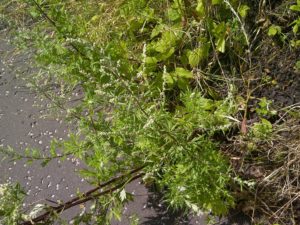I was hoping the Old English Lacnunga would translate into a good poem for Haggards, but it really doesn’t. I might write my own Charm of Nine Herbs at some point, but while I was working at the original, I have done some research that might be interesting. The link I’ve given is to a parallel text, original and (sort of) translation. It’s not great, but some of the tricky words exist only in this text, and translators seem to choose meanings that fit their own theories. Very few of them seem to have much background knowledge of either herblore or Old English – the Penn State Garden site is an exception here, but does suffer from Dark Age syndrome – where the past is full of magic and ignorance and can safely be assumed to be wrong.

Anyway, I’m going to offer an attempt at translation, and a bit of background research, on the assumption that the Dark Ages might have lacked technical language and scientific theory, but they were good at observation and response.
Mugwort, remember * what you proclaimed,
what you laid down * in the Lord’s Decree.
First, you are called, * oldest of herbs.
You have the power * over three, over thirty.
You have power over venom, * over airborne infection.
You have power over the evil one * who wanders the world.
Mugwort was used to flavour beer, as a substitute for tea, or even tobacco in Orkney, (source Flora Celtica, published by Birlinn Books and edited by William Milliken and Sam Bridgewater). Dried leaves were used to deter fleas and to repel moths. Stems were used to make baskets. It was sometimes known as St John’s girdle, because it was believed St John the Baptist wore it, and was believed to have power to preserve from fatigue, sunstroke, wild beasts and evil spirits. Medicinally it was used for diseases of the stomach and liver, as an antidote to poison, for fevers and nervous conditions (source A Modern Herbal M.Grieve). Credited with magical powers, it was planted to protect a house from elves (Geoffrey Grigson Englishman’s Flora) and was carved on roof bosses in churches, particularly Exeter cathedral.
The Lord’s Decree was popularly held, in early Christian times, to be what Christ taught his disciples between the Resurrection and the Ascension. Of course, where communities were mixed, pagans might have attributed this wisdom to someone else entirely, but healers don’t seem to have worried overmuch. There are references to the Bible and to Woden side by side in this text.
I’ve been a bit baffled by the word ‘attre’, which I have translated as ‘venom’. It means ‘poison’ or ‘plague’, but what I think is meant is ‘contamination’ – poison, literally, but also septicaemia, toxins, pollution or bacterial infection. It is often paired with ‘onflyge’, which means literally ‘flying in’ and must be related to the word ‘influenza’ – disease that comes in the air, or because of the weather. Or as we might say, when there’s something going round.
The evil one, wandering the world, is a reference to Satan in the Book of Job (1:7). It came in handy for Grendel, too.